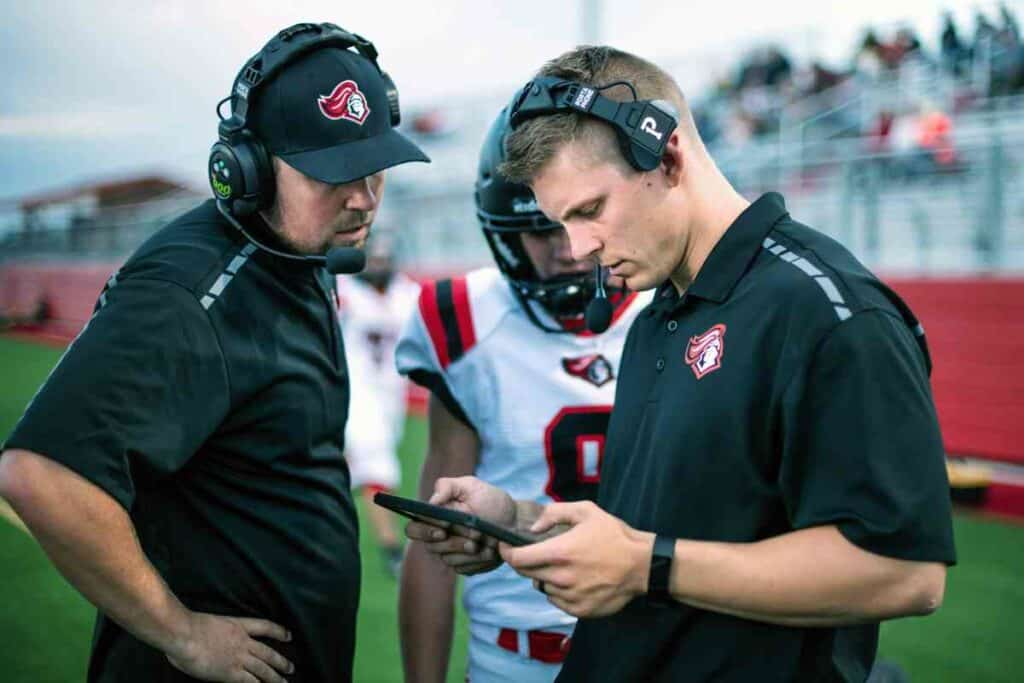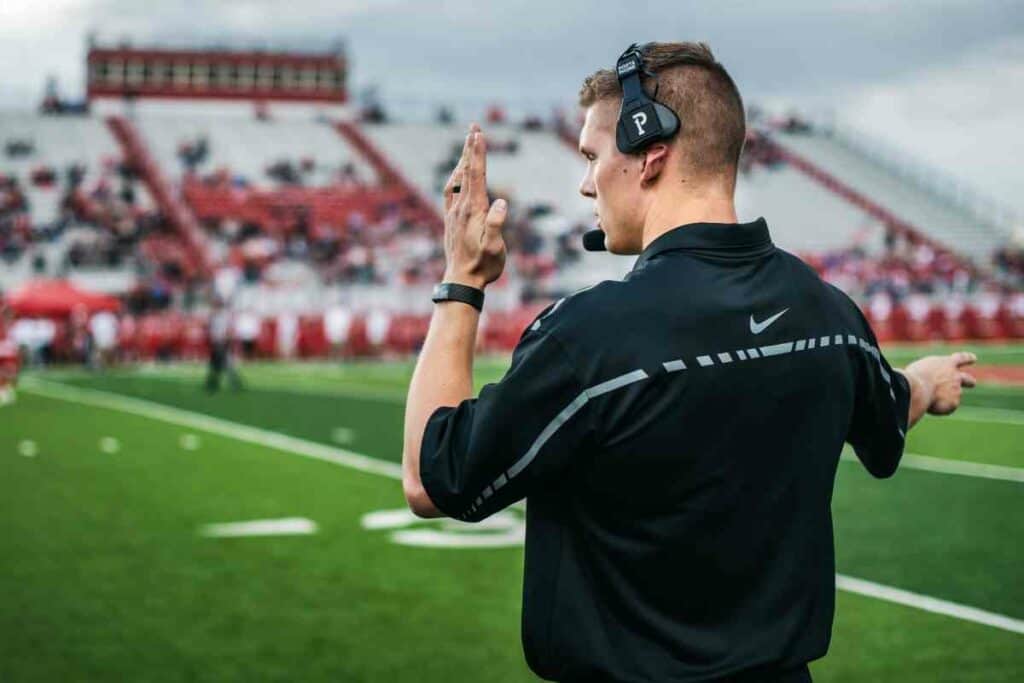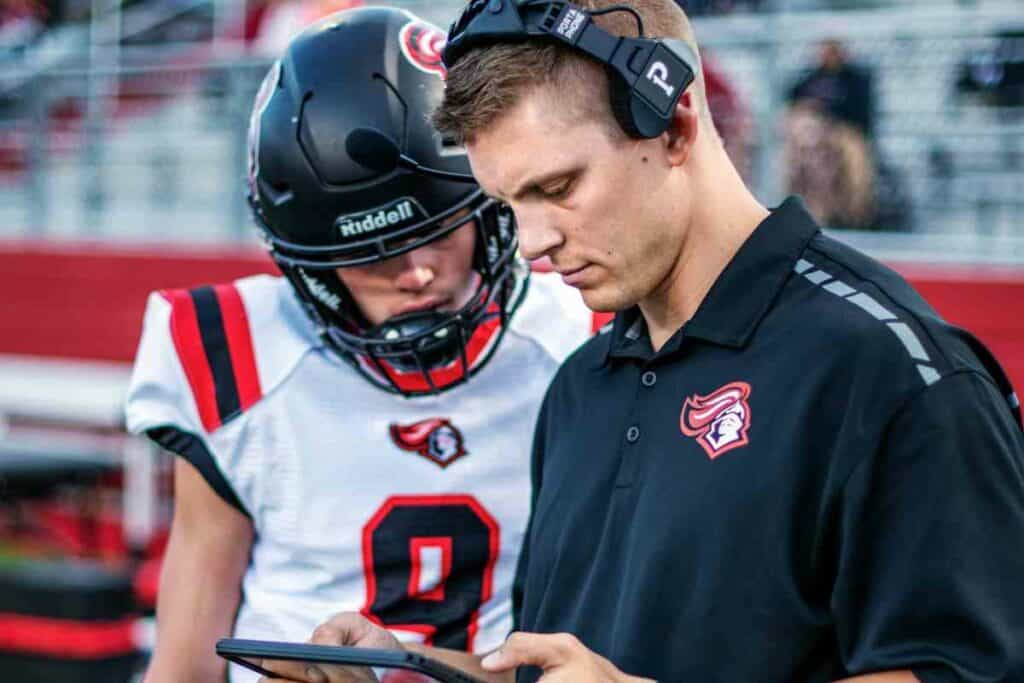Average D1 College Football Coach Salary: Insights into Coaching Compensation
Imagine stepping into the high-stakes arena of Division I college football, where the roar of the crowd echoes the colossal importance of each game. Here, the coaches are much more than sideline strategists; they’re pivotal players in a multi-million-dollar spectacle. But have you ever wondered what lies behind their hefty paychecks?

Related Posts! How Much Do D2 Football Coaches Make and How Much A D3 College Football Coach Makes!
How Much do D1 College Football Coaches Make?
Division I college football coaches command significant salaries, with an average around $2.7 million. However, top coaches in prominent programs can earn over $9 million annually. Their compensation includes base salary, bonuses for performance, and additional benefits, reflecting the high value and revenue potential of successful collegiate football program.
Picture yourself at the heart of a major college football program, where the coach’s salary is not just a number, but a reflection of success, reputation, and the university’s commitment to athletic excellence.
Components of a Coach’s Pay: When you think of a coach’s pay, it’s a combination of various financial sources:
- Base Salary: This is their guaranteed annual income, the foundation of their earnings.
- Bonuses: Imagine the thrill of winning a big game or clinching a conference title, and there’s a monetary reward waiting!
- Benefits: Often overlooked but vital, these include health insurance, retirement plans, and sometimes even housing or car allowances.
Driving Factors Behind Salaries: What catapults one coach’s salary above another? It’s a blend of:
- Team Performance: The better the team, typically the higher the coach’s salary.
- Coach Experience: Seasoned coaches with a history of success often command larger paychecks.
- Program Revenue: Teams that rake in more money can afford to be more generous with their coaching staff.
Your understanding of this realm is now more than just cursory; it’s insightful, allowing you to appreciate the complexities and controversies that swirl around these towering figures in collegiate sports.
Top Earners in College Football Coaching
In the realm of college football, the salaries of head coaches are often a reflection of their program’s success and prominence. Here, we look at those who stand at the pinnacle of this lucrative field.
Highest-Paid Head Coaches
Nick Saban, the head coach of Alabama, has been a consistent top earner in college football coaching. With multiple national championships under his belt, his compensation package often includes both a substantial base salary and performance bonuses. Nick Saban was the highest paid football coach with earnings surpassing $11 million in a recent year.
Dabo Swinney at Clemson and Jimbo Fisher at Texas A&M have also ranked as top earners alongside Saban. Their contracts reflect their roles in transforming their respective programs into national contenders. Not far behind in earnings are highly regarded coaches like Kirby Smart of Georgia and Ryan Day of Ohio State, who receive compensation packages commensurate with their teams’ performances.
Related Post! NAIA Coach Salaries
Contracts of Prominent Figures

The contracts of college football’s leading coaches entail more than just salary. They can include incentive bonuses, retention bonuses, and various performance-related benefits. For instance, Ed Orgeron, former head coach at LSU, had a considerable contract before his departure from the program.
Prominent deals were also inked by Mel Tucker at Michigan State, Jim Harbaugh at Michigan, and David Shaw at Stanford, reflecting the competitive nature of retaining top coaching talent. Newcomers to the highest-paid tier like Lincoln Riley and Brian Kelly, who recently accepted positions at USC and LSU respectively, have set new benchmarks with their lucrative contracts which present a shift in the collegiate coaching landscape.
| Coach Name | University | Annual Salary |
|---|---|---|
| Nick Saban | Alabama | $11.13M |
| Dabo Swinney | Clemson | $10.65M |
| Jimbo Fisher | Texas A&M | $9.00M |
| Kirby Smart | Georgia | $7.13M |
| Ryan Day | Ohio State | $6.61M |
| Ed Orgeron | LSU (Former) | $9.01M |
| Mel Tucker | Michigan State | $5.56M |
| Jim Harbaugh | Michigan | $7.50M |
| David Shaw | Stanford | $4.51M |
| Lincoln Riley | USC | Est. $8M |
| Brian Kelly | LSU | $9.50M |
These figures exemplify the unprecedented scale of remuneration among the elite of college football coaching.
Picture yourself at the crossroads of sports and law, where the contracts of Division I college football coaches are crafted. These contracts are more than just employment agreements; they are intricate documents balancing performance, legal stipulations, and financial rewards.
Contractual Nuances and Legal Framework:
- Incentive Structures: Your salary isn’t just a number on paper. It can swell with bonuses linked to victories, academic achievements of your team, and playoff successes. These incentives aren’t just perks; they’re significant elements of your financial package.
- Obligations and Compliance: As a coach, you’re tasked with more than just game strategies. Recruiting top athletes and adhering to NCAA regulations are integral parts of your contract.
Mitigation and Termination Clauses:
- Seeking New Opportunities: In the event of a contract termination, a mitigation clause nudges you towards finding new coaching roles, affecting the buyout terms from the university.
- Buyout Details: If your journey with the university ends prematurely, a buyout clause kicks in. This could be a lump sum or a pro-rated amount based on the contract duration served.
- Ending the Contract: Termination clauses outline the ‘how’ and ‘why’ your contract can be ended, including reasons like non-performance or violations.
Key Elements to Understand in Your Contract:
- Incentive Structures: Additional pay for meeting specific targets.
- Obligations: Your duties as outlined in the contract.
- Mitigation Clause: Requirement to seek similar employment upon termination.
- Buyout Owed: Compensation for early contract termination.
- Lump Sum Payment: How some buyouts are structured.
- Termination Conditions: Guidelines for ending the contract.
- Pro-Rating for Partial Year: Adjusting the buyout for partial year service.
- Retention Bonuses: Rewards for staying with the program for a set duration.
The Interplay of Performance, Salary, and Job Security:

- Performance as a Salary Lever: Success on the field can catapult your salary to new heights. Conversely, underperformance can stagnate or even diminish your earnings.
- Coaching Tenure and Stability: The life of a D1 football coach is marred with uncertainties. Consistent wins can secure your position, while a lack of success or infractions can lead to termination.
Factors Influencing Coaching Stability:
- Pressure to Win: This is a key determinant of your job stability.
- Revenue Targets: Your team’s performance impacts revenue streams, from media deals to ticket sales.
- Varied Firing Practices: Each university has its approach, but buyouts are common in cases of termination without cause.
Insights From Data and Statistics
Have you ever wondered how the salaries of college football coaches stack up against each other? Let’s dive into the fascinating world of college football finances and explore what goes into the paycheck of these influential figures.
Diversity in Salary Across Conferences
When you look at the salaries of Division 1 (FBS) head coaches, the differences are eye-opening. Using data sources like USA Today’s comprehensive database, we see a clear division:
- Power Five Conferences: These elite coaches often enjoy salaries exceeding $3.37 million.
- Group of Five Conferences: Here, coaches receive more modest but still significant compensation.
Understanding the Impact of NCAA Statistics
How do athletic performance and academic progress rates influence a coach’s salary? Delving into the NCAA’s statistics offers a wealth of insights. These numbers not only reflect the coaches’ financial worth but also shed light on the strategic financial decisions of athletic departments.
College vs. NFL: A Striking Contrast
In the realm of football coaching salaries, a stark difference emerges when comparing collegiate and NFL coaches:
- Average D1 College Football Coach Salary: Around $2.7 million.
- Average NFL Coach Salary: A whopping $6 million.
This gap is influenced by several factors, such as:
- Revenue Generation: NFL franchises’ higher revenues significantly boost salary potentials.
- Contract Complexity: NFL contracts often feature intricate incentives and bonuses.
- Market Competition: The demand for professional coaches drives up their salaries.
- Media Rights: The NFL benefits from more lucrative broadcasting deals.
The Pandemic’s Influence
COVID-19 has left its mark on college football coaching salaries. The financial strains on universities led to:
- Salary Adjustments: Many coaches faced reductions, freezes, or restructured contracts.
- Post-Pandemic Recovery: As the financial impact lessened, salaries began to normalize, with some coaches even benefiting from new bonus structures.
Negotiations and Agents
In the high-octane world of Division I college football, understanding contract negotiations becomes crucial. Here, the role of agents is not just significant but transformative in shaping a coach’s career trajectory and financial security.
The Vital Role of Agents in Contract Negotiations
Think of agents as the architects behind a coach’s financial success. They are the champions advocating for coaches, ensuring their interests are both protected and maximized. Consider the cases of James Franklin and Steve Sarkisian, where adept agents have been game-changers in their career paths.
Key Responsibilities of Agents
- Negotiating Salaries: Agents are the maestros of securing the most lucrative financial deals for their clients.
- Crafting Contracts: They skillfully include bonuses and incentives, aligning compensation with performance.
- Guiding Career Progression: Agents are instrumental in steering coaches towards opportunities that enhance their professional growth.
How Representation Influences Coach Salaries
The quality of an agent directly impacts a coach’s salary. Top-tier agents like Robert Lattinville, with connections to firms like WME, leverage their vast networks and expertise. They are the forces behind contracts for high-profile coaches like Dan Mullen and Gary Patterson, securing them financial security.
Agents bring to the table:
- Expertise: Their knowledge of market trends and legal nuances is invaluable.
- Bargaining Power: This is essential for negotiating top-tier salaries and benefits.
- Athletic Directors Interaction: Effective communication with athletic directors can significantly sway contract negotiations.
Recent Shifts in Coaching Positions
The college football landscape is ever-changing, with recent shifts impacting team dynamics and salary structures.
Noteworthy Coaching Changes
- Texas: Bid farewell to their head coach following underwhelming performance.
- Georgia: Retained their head coach with an improved contract post a successful season.
- Michigan: Extended their coach’s contract, reflecting increased salary benchmarks.
- Clemson: Made waves by hiring a high-profile coach, aiming to revitalize the team.
- LSU: Opted for a coaching change, sparking a hunt for fresh talent.
- Florida: Made the bold decision to let go of their head coach mid-season.
- Michigan State: Secured their coaching future with a lucrative deal.
- North Carolina: Demonstrated commitment by bringing on a coach renowned for team revivals.
- Rutgers: Saw Greg Schiano gain a rewarding contract extension.
Further changes at institutions like Arkansas State, Colorado, TCU, Oklahoma, and others signify an evolving coaching landscape.
The Ripple Effect on Salary Structures
The 2023 season has witnessed significant shifts in salary dynamics, driven by these coaching changes:
- Arkansas State: Competitive hiring led to heightened salaries.
- TCU: Increased salary caps to attract premier coaching talent.
- Oklahoma: Adjustments in bonus structures and incentives.
- Utah: A salary rise following a strong season.
Other schools like Colorado, Fresno State, and Massachusetts have also adapted their compensation packages to stay competitive. This trend reflects a market where successful coaching appointments lead to salary hikes, while those with lesser success might see stagnation or reduction in their compensation.
Career Pathways and Progression
The journey to becoming a Division 1 head coach in college football is a tale of unwavering dedication, strategic career advancement, and continuous skill development. It’s a path marked by numerous challenges and milestones.

The Road to D1 Head Coaching
Embarking on this path typically begins with humble origins, often as an assistant coach. Here, patience is more than a virtue; it’s a necessity. The climb to a head coaching position can span over a decade, involving:
- Building a Strong Reputation: Through various coaching roles, you carve out your identity in the coaching community.
- Developing Expertise: A relentless focus on recruiting, coaching skills, and building a robust professional network.
A typical career trajectory could be:
- Graduate Assistant
- Position Coach
- Coordinator (Offensive/Defensive) (Check out my article on how much NFL Offensive Coordinators make)
- Head Coach at a Division II or III institution
- D1 Head Coach
Take Mack Brown’s career as an exemplar, showcasing the impact of diverse coaching experiences and a solid track record.
Related Post: Every Football Position Explained!
Sustaining a D1 Coaching Career
Longevity as a D1 head coach hinges on several factors:
- Consistent Success: Your on-field triumphs are vital.
- Program Stability: How you manage both the athletic and academic performance of your athletes plays a significant role.
- Strategic Decision-Making: From staffing choices to game strategies.
- Navigating College Football Complexities: Including recruitment and salary negotiations.
- Adaptive Compensation: Typically includes base salary plus performance-based incentives.
Continual learning and adapting to the ever-evolving college football landscape are crucial for career progression. Participation in coaching clinics, new certifications, and innovative training methods are essential.
Evolving Compensation in College Football Coaching
Historical changes in Division 1 football coach salaries mirror the evolution of college athletics, with a marked growth in compensation.
- Mid-20th Century: Coaching salaries were modest, comparable to academic salaries.
- 1980s-1990s: Salaries began to rise notably, often surpassing those of university presidents.
- 2000s-2010s: Compensation packages expanded, with top coaches earning significantly more.
Decades of Salary Growth
- 1970s-1980s: Salaries ranged from $25,000 to $60,000.
- 1990s-2000s: Compensation, including bonuses and endorsements, pushed into the hundreds of thousands.
- 2000s-2010s: Salaries expanded from $200,000 to over $2 million.
- 2020s: Salaries have soared, reaching upwards of $9 million annually.
This escalation in compensation reflects the immense revenues generated by successful football programs. From TV deals to merchandising and ticket sales, the financial stakes have skyrocketed, paralleling the expectations placed on coaches to deliver both wins and financial returns.
Frequently Asked Questions
What are the average salaries for Division I college football coaches in 2023?
The average salaries for Division I college football coaches in 2023 vary widely but generally fall within a high six to seven-figure range.
Which NCAA football coach tops the salary chart in 2023?
In 2023, the NCAA football coach with the highest salary is likely commanding upwards of seven figures, positioning them among the highest-paid individuals in academia and sports.
How do salaries of top NCAA football coaches compare to NFL coaching salaries?
Comparatively, top NCAA football coaches’ salaries often approach, but generally do not surpass, those of their NFL counterparts, who command multimillion-dollar earnings due to the professional league’s revenue-generating nature.
Are there significant differences in pay between Division I and Division II football coaches?
Yes, there are marked differences in pay between Division I and Division II football coaches, with Division I coaches typically receiving substantially higher compensation due to the higher profile and profit-generating potential of their programs.
What are the salary trends for Big Ten football coaches in 2023?
Salary trends for Big Ten football coaches in 2023 reflect a steady increase, reinforcing the Big Ten’s reputation for offering competitive pay to attract top coaching talent.
How do college football coach salaries correlate with team performance or winning records?
College football coach salaries often reflect, and are justified by, a team’s performance or winning record, with higher salaries frequently correlating with successful programs and championship victories.
